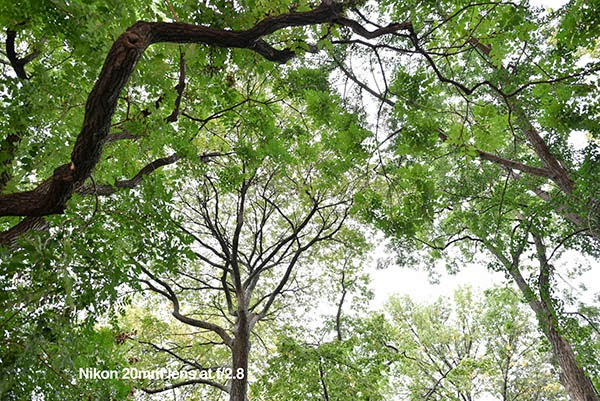This lens has been a long awaited -- by me at least -- update of the original Nikkor 20mm f/2.8D lens design that is 30 years old. In the film era this lens had always been my favorite super-wide, but on a digital camera it showed its age and was, to my mind, totally unusable. Although updated several times with mechanical changes, the optical system of the f/2.8 lens has remained the same as that of the original 1984 model. The new version not only refreshes the optical layout with a new design containing ED glass and aspherical elements, but adds over one stop to the maximum aperture.
Even with its extra f/stop, and 77mm as opposed to 62mm filter size, the new lens weighs in slightly more that 3oz than the older f/2.8 version (9.52oz) and does not exhibit the bulkiness of zoom lenses in a similar focal range. In other words, its a perfect super-wide option for when you want to travel light.
The real problem for resolution with a super-wide is usually found in the corners. This lens does not disappoint. Although at its most extreme aperture you can detect some corner softness, I did not find it objectionable, and once the lens is stopped down even to f/2.8 it is acceptable, and really good at f/5.6 as you would expect, and is probably the range where most of us would normally use a lens like this. If this lens had come out with an f/2.8 aperture this review would be even better and I would have been content simply for an updated replacement of the older model. As it is, the f/1.8 aperture is an added bonus that will undoubtedly come in handy for many applications.
Below are some sample images where you can download high res files to judge the performance for yourself. All were shot as original jpgs.
A 20mm focal length is very well suited to capturing subjects like night time starry skies and the fast f/1.8 aperture allows working at a lower ISO for better noise control, while also keeping the exposure time down so as not to blur the stars.
Despite its appearance in one extreme example below of the interior of Grand Central Station, the correction for chromatic aberration in this lens is really excellent. The green tree image below is a test I do for chromatic aberration.
 |
| This is a lens test I do for chromatic aberration by shooting an open image of leaves over-exposed against a bright sky. I know from experience that chromatic aberration is almost always present in a shot like this. With the Nikon 20mm lens it is almost non-existent except in subtle traces towards the top of the frame. Click here to download the high res version of this file. |
 |
| This image of the Brooklyn Bridge and World Trade Center is typical of the way I would normally use a 20mm lens for a travel shot. Taken at f/5.6 on a D750 the focus is sharp everywhere, even in the corners. Click here to download a high res version of this file. |
 |
| Note the chromatic aberration occurring in the bright window area at the bottom of the frame. To be fair, this is exactly the set of circumstances where I would expect this type of fringing to occur with almost any lens. Fortunately, it is very easy to correct. Click here to download a full res version of this file. |
The scene below (taken with a 16mm focal length) is typical of how I shoot a landscape with a super-wide lens. I put the focus in the foreground and stop down enough to obtain enough detail in the background. The foreground is usually filled with detail that I want to preserve. If a lens cannot hold detail in its corners, it becomes glaringly obvious in a shot like this. The test I do to determine how a lens will perform in this situation is shown in the photo below this one of a cobble-stone street.
 |
The close-up range of 7.9" makes it easy to get right on top of your subject, closer than the super-wide zooms. |
Conclusion:
Stopped down, which is where a lens like this is typically used for landscape photography, the results are impressive with edge-to-edge sharpness. It's fast f/1.8 aperture is an added bonus useful for dimly lit interiors and night photography. It comes in a light-weight package and can easily replace in weight and performance any of the heavier zoom lenses that hover around this focal length.
The resolution for this 20mm lens is no match for the Nikkor 24mm f/1.4, but it is much wider and, at $796.95, less than half the price. For me it has already become a welcome addition to my camera bag and I will probably sell off one of my shorter zooms -- like the much slower 18-35mm, which it out-performs -- to make room for it.
If you are planning on buying this lens, you can help support this site at no extra cost to you by clicking the link and purchasing from one of our affiliate sellers listed below -- and thanks for your support.











































